A bowl of Sinigang is magical. This is not soup; it is a sensation. For every Filipino, probably, this is the dish that transforms a normal meal into an event-being personal, warm, and celebration-like. But if you’re not familiar yet with Sinigang Recipe, welcome-there you are on the verge of tasting one of the best sour soups ever created.
Not only does the Sinigang Recipe have this wonderful ability to combine the sharpness, savoriness, and the substantial, but, it feels like a hug for your palate. Whether for those wet, cozy days or just for the taste of a classic Filipino dish, Sinigang has it uncompromisingly.
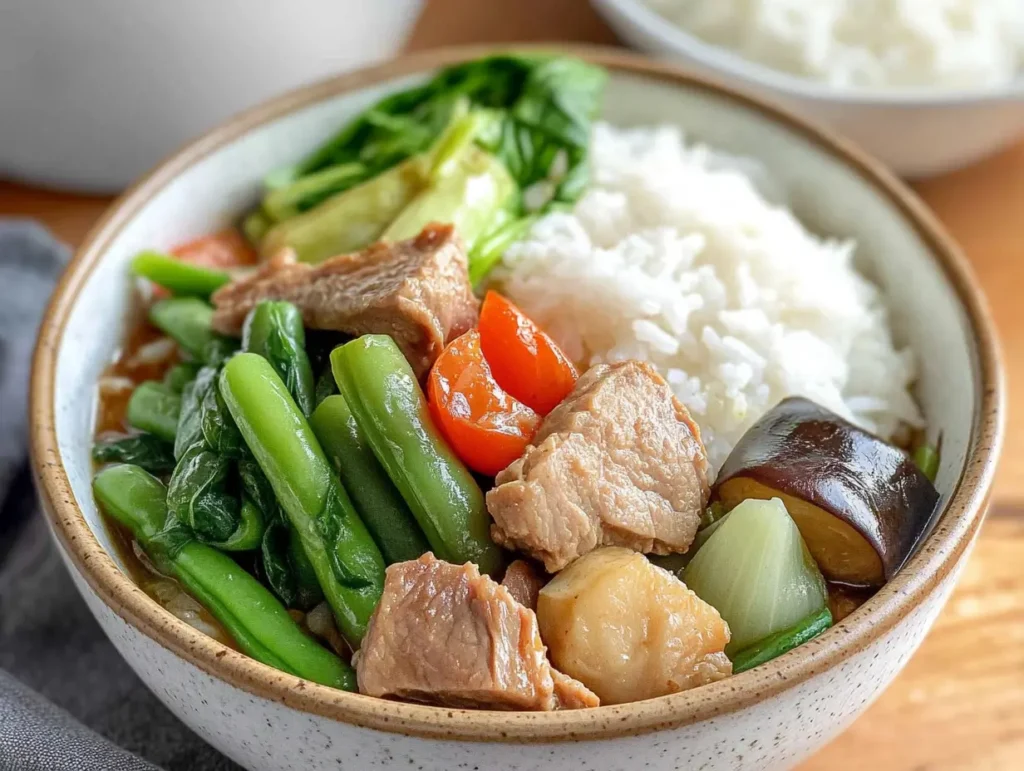
I am here to talk about the Sinigang Recipe-basic guide to the essential tips, ingredient swaps, and even some cultural background. Without further ado, let’s get started!
What is Sinigang Recipe, Anyway?
What really is Sinigang, to begin with?
Sinigang (pronounced “see-nee-gahng”) is a sour broth soup or a stew in the Philippines. This is known for its sourness and is usually flavored with tamarind. Aside from this tangy base, it is loaded with vegetables such as radish, eggplant, and other vegetables called sitaw along with a protein such as pork, shrimp, or fish.
Above all, one of the best things about Sinigang is how varied it can be. After all, it’s like that little black number-‘ still resplendent enough for that special dinner, yet simple enough for that quick weeknight meal.
The Flavor Profile of Sinigang Recipe
Sour, savory, and oh-so-satisfying. That’s how I’d describe the flavor of Sinigang Recipe. The tanginess comes from tamarind, which gives the soup its signature zing. If you’ve never cooked with tamarind, don’t worry—it’s easy to find tamarind soup base packets in most Asian grocery stores.
But Sinigang isn’t just about the sourness. It’s also savory from the meat and fish sauce, earthy from the veggies, and even a little sweet if you’re using ripe tomatoes. The flavors all blend together beautifully, making it the kind of dish you’ll crave again and again.
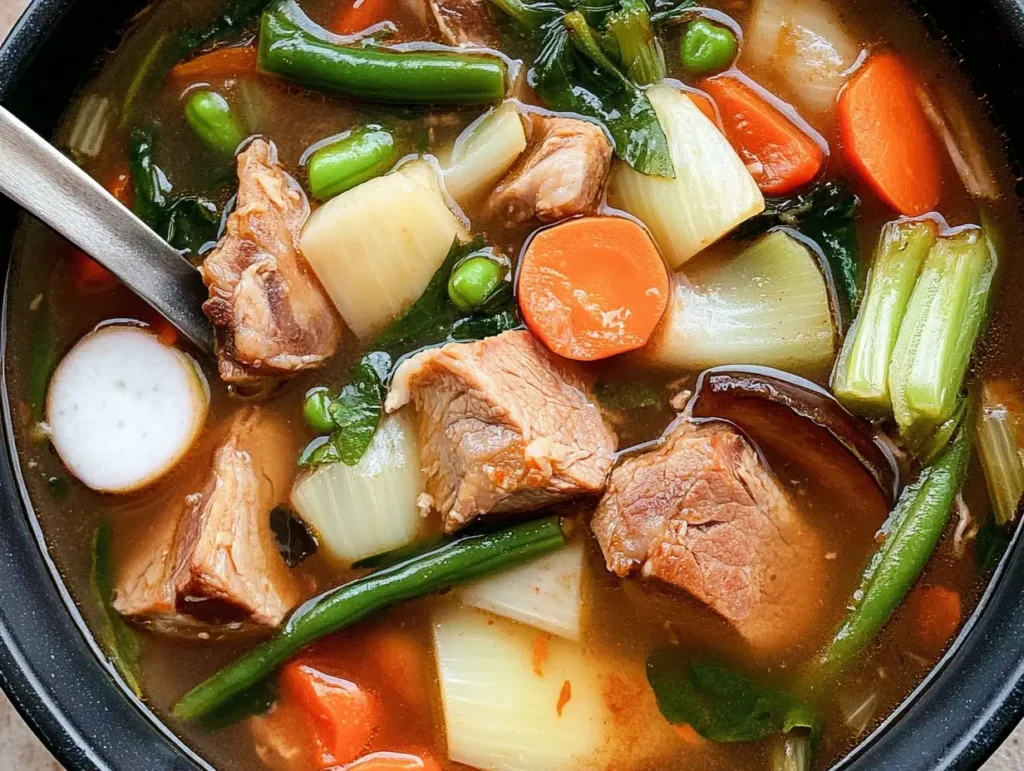
Why Sinigang Recipe is Perfect for American Kitchens
Okay, let’s talk about why Sinigang Recipe is a must-try, especially if you’re cooking in the U.S.
For one, it’s forgiving. You don’t need fancy equipment or hard-to-find ingredients. Even if you can’t track down kangkong (water spinach), baby spinach or kale works just fine. Tamarind mix? You can grab it online or in the international aisle at your local grocery store.
In addition, it’s something that most people would tend to enjoy. Kids love the sourness of the broth, while adults revel in the depth of flavor; not to mention, it’s naturally full of vegetables, so really, it’s not trying too hard to feel wholesome.
Sinigang Recipe: Step-by-Step Guide
Now that we’re all hyped up about Sinigang, let’s get cooking. This Sinigang Recipe makes enough for about 4–6 servings, but feel free to double it if you want leftovers (trust me, it tastes even better the next day).
Ingredients:
For the Soup Base:
- Pork belly or ribs – 1 lb. (Shrimp or fish works great too!)
- Tamarind soup base mix – 1 packet (or fresh tamarind if you’re feeling fancy).
- Water – 6 cups, or enough to cover the meat.
For the Vegetables:
- Tomatoes – 2 medium, quartered.
- Onion – 1 large, peeled and cut into wedges.
- Daikon radish – 1 medium, sliced into rounds.
- String beans – A handful, trimmed.
- Eggplant – 1 medium, sliced into thick half-moons.
- Kangkong (water spinach) – 1 bunch (sub with spinach or bok choy).
- Okra – Optional, but a great addition if you can find it.
Seasoning:
- Fish sauce – 2 tablespoons (or adjust to taste).
- Black pepper – A pinch, for a little kick.
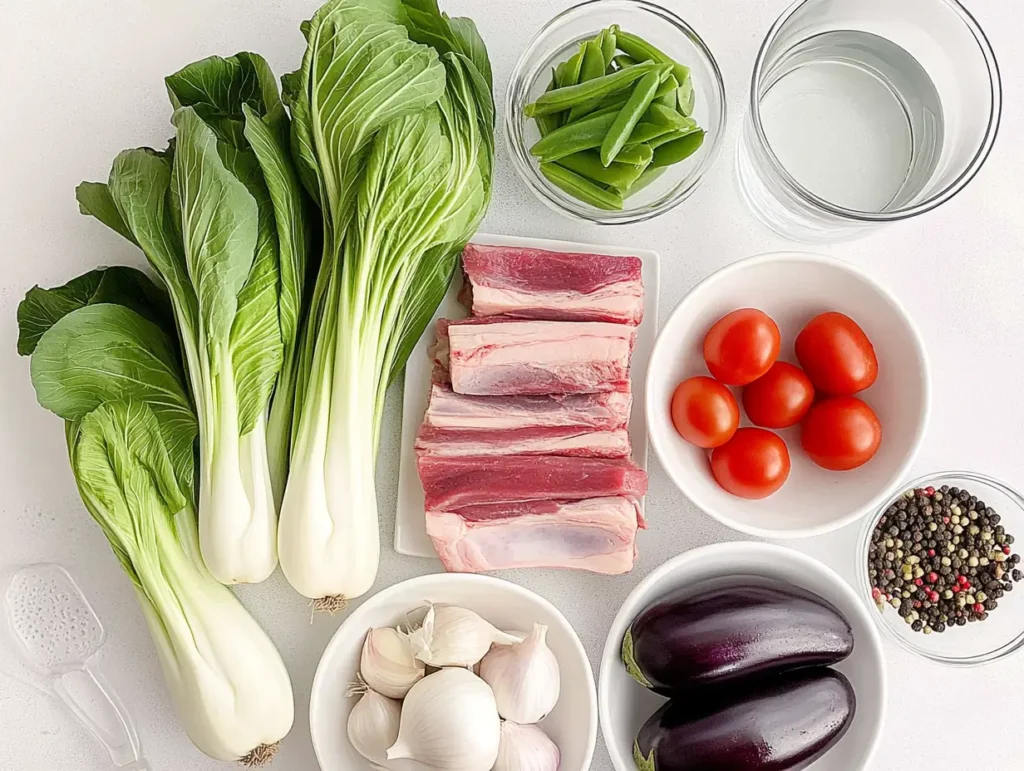
Cooking Instructions for Sinigang Recipe
1. Prep Your Ingredients
Chop all your vegetables, clean your meat; especially pork belly or ribs, cut those into bite-size pieces to make it all the more easier to cook and eat. Honestly, it saves time and makes the whole process much smoother when you prep everything first.
2. Boil the Pork
The next step is to introduce the pork, onions, and tomatoes into a large pot. Add water (approximately six cups) to cover everything and bring to a boil. Skim any foam that appears during cooking to keep the broth clear and clean.
Simmer the pork for about 45 minutes to 1 hour, or until fork-tender and juicy.
3. Add the Tamarind Mix
Once the pork is cooked through, stir in the tamarind mix. Start with half the packet, taste the broth, and add more if you want it extra tangy. Everyone’s sour tolerance is different, so adjust as you go.
4. Cook the Veggies
Add the radish, string beans, and eggplant first, since they take longer to cook. Let them simmer for about 5–7 minutes. Then toss in the kangkong and okra, cooking for another 2–3 minutes until everything is tender but not overcooked.
5. Season to Taste
Finally, stir in the fish sauce and black pepper. Taste the broth one last time and adjust the seasoning as needed. And that’s it—your Sinigang is ready to serve!
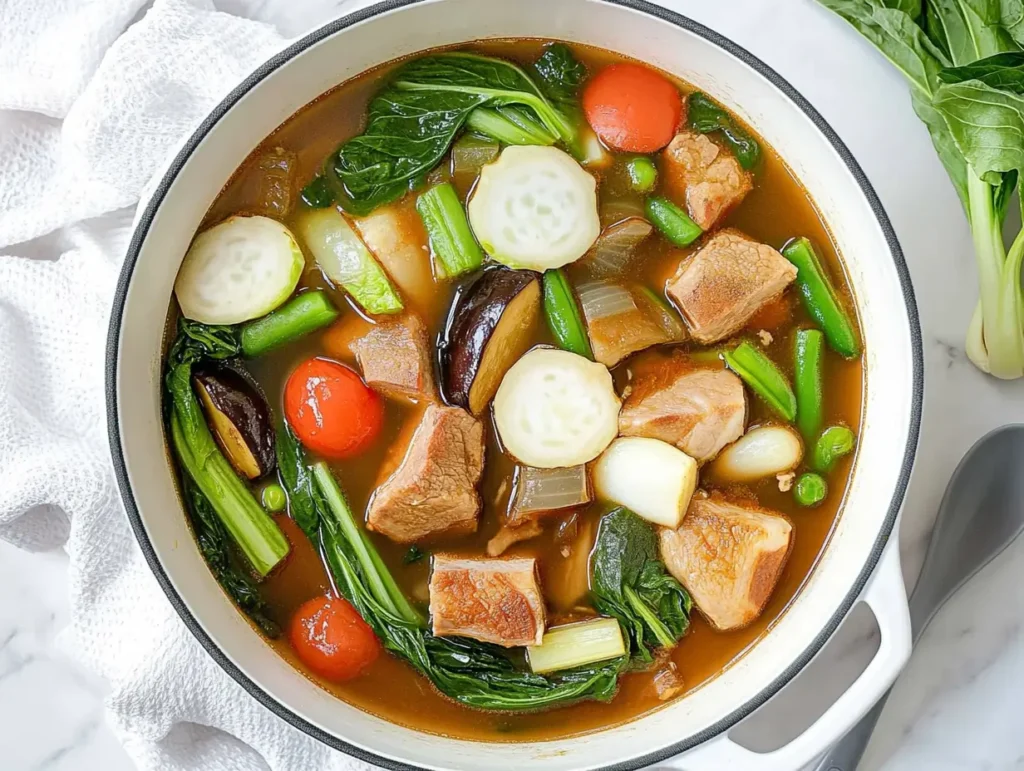
Serving Sinigang
Sinigang Recipe is best served hot, preferably with a big bowl of steamed white rice on the side. The rice soaks up all that tangy, savory goodness, making every bite a perfect combo of broth, veggies, and meat.
Want to take it to the next level? Pair it with some crispy fried fish or grilled shrimp on the side. The crunchy texture complements the soup beautifully.
Looking for more hearty meal ideas? Check out our dinner recipes. You’ll find dishes that are just as satisfying and delicious!
Sinigang Recipe: Ingredient Swaps and Variations
One of the coolest things about Sinigang Recipe is how adaptable it is. Here are a few ways you can make it your own:
- Swap the protein. Try shrimp, chicken, or even tofu for a lighter version. Salmon belly is another popular choice if you love seafood.
- Experiment with veggies. Don’t have radish? Use zucchini or carrots. No string beans? Snap peas are a great alternative.
- Go all-natural. If you want to skip the tamarind mix, you can use fresh tamarind pods or even calamansi juice for a natural sour flavor.
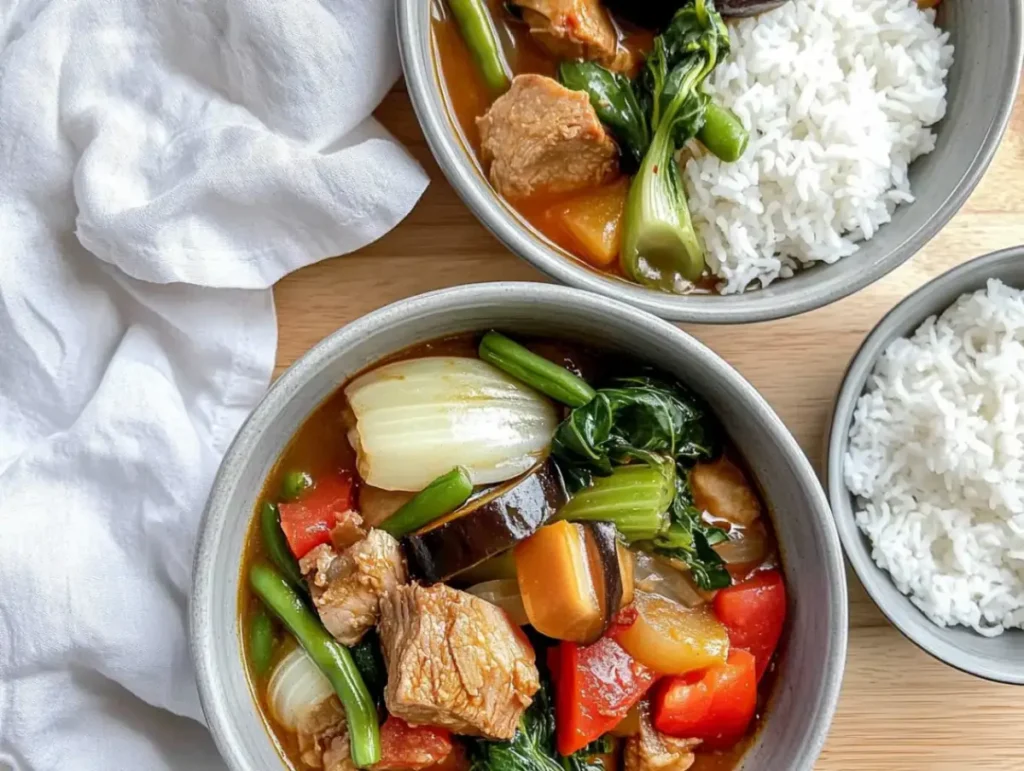
Tips for First-Timers
If this is your first time making Sinigang, here are a few tips to help you nail it:
- Taste as you go. The broth is the star of the show, so don’t be shy about tweaking the sourness and saltiness to your liking.
- Don’t overcook the veggies. They should be tender but still have a little bite to them.
- Save leftovers. Sinigang tastes even better the next day because the flavors have more time to meld together.
Why Americans Love Sinigang Recipe
If you’re wondering why Sinigang has been making waves in the U.S., it’s simple: it’s comforting, unique, and surprisingly approachable. The tangy broth feels familiar (think chicken soup with a twist), but the tamarind gives it that wow factor.
One would really appreciate wholesome meals. Aside from that, it is naturally gluten-free and filled with vegetables. That is why Sinigang has won the hearts of food bloggers as well as those restaurants in-the-know across the States.
A Little History
Before we wrap up, let’s talk about Sinigang’s roots. This dish has been a staple in Filipino households for generations, and its exact origins are hard to pin down. What we do know is that Sinigang is deeply tied to Filipino culture—it’s the kind of dish that brings families together around the table.
The use of tamarind as a souring agent likely dates back centuries, but over time, Sinigang has evolved to include modern shortcuts like powdered tamarind mix. Despite these changes, the essence of the dish remains the same: simple, hearty, and always made with love.
FAQs about Sinigang Recipe
What is Sinigang Made Of?
Sinigang is a traditional Filipino sour soup known for its tangy flavor and hearty ingredients. The main components of Sinigang include:
- Protein: Common choices are pork (belly or ribs), shrimp, fish, or chicken.
- Souring Agent: Tamarind is the most popular, but calamansi, green mango, or kamias can also be used.
- Vegetables: A variety of veggies are included, such as tomatoes, onions, radish, string beans, eggplant, okra, and kangkong (water spinach).
- Seasonings: Fish sauce, salt, and black pepper are used to boost the flavor.
Is Filipino Sinigang Healthy?
Yes, Sinigang is a healthy dish, especially when loaded with fresh vegetables and cooked with lean proteins. Here are a few reasons why:
- Low in Calories: The broth-based soup is light and not heavy on fats or carbs.
- Rich in Nutrients: Vegetables like kangkong, radish, and eggplant are packed with vitamins and minerals.
- Good Source of Protein: Depending on your choice of meat or seafood, Sinigang provides a healthy dose of protein.
- Gluten-Free: Naturally gluten-free, making it ideal for those with dietary restrictions.
- Low in Saturated Fats: If made with leaner cuts of meat or seafood, Sinigang is heart-healthy.
For an even healthier version, you can reduce the use of fish sauce or salt and increase the vegetable content.
What About Sinigang and Its Multiple Ingredients?
One of the standout features of Sinigang is its flexibility when it comes to ingredients. It’s a dish that adapts to what’s available in your pantry or fridge. Here’s how its ingredients can vary:
- Souring Agents: While tamarind is the classic choice, other souring ingredients like calamansi, kamias, or even vinegar are used in some regional variations.
- Protein Choices:
- Pork is traditional and provides a rich, savory broth.
- Seafood like shrimp or milkfish (bangus) creates a lighter, briny version.
- Chicken is less common but still delicious, especially for those who prefer white meat.
- Vegetable Variety:
- Typical veggies include kangkong, radish, string beans, and eggplant.
- Regional twists might include green mangoes, gabi (taro), or malunggay leaves.
- Seasonings: Fish sauce is traditional, but salt or soy sauce can be used as substitutes.
Sinigang’s adaptability makes it a beloved dish across the Philippines, with each household adding their unique spin. Whether you stick to the classic recipe or mix it up with your favorite ingredients, Sinigang is always a comforting and satisfying meal.
Final Thoughts on Sinigang Recipe
No matter whether you are Finnish or a food lover seeking some new dishes, Sinigang will be worth adding to your repertoire. It is sour; it brings comfort; and it has an endless scope of customization and it guarantees success in your cooking endeavors regardless of who the eaters are.
So next time you’re in the mood for something cozy and flavorful, grab a pot and give this Sinigang recipe a try. Your taste buds will thank you—and who knows, it might just become your new favorite comfort food.
PrintSinigang Recipe: A Tangy, Comforting Filipino Classic
A bowl of Sinigang is magical. This is not soup; it is a sensation.
- Prep Time: 15 minutes
- Cook Time: 1 hour
- Total Time: 1 hour 15 minutes
- Yield: 4 servings
- Category: Dinner
- Method: Boil
- Cuisine: Filipino
Ingredients
For the Soup Base:
- Pork belly or ribs – 1 lb. (Shrimp or fish works great too!)
- Tamarind soup base mix – 1 packet (or fresh tamarind if you’re feeling fancy).
- Water – 6 cups, or enough to cover the meat.
For the Vegetables:
- Tomatoes – 2 medium, quartered.
- Onion – 1 large, peeled and cut into wedges.
- Daikon radish – 1 medium, sliced into rounds.
- String beans – A handful, trimmed.
- Eggplant – 1 medium, sliced into thick half-moons.
- Kangkong (water spinach) – 1 bunch (sub with spinach or bok choy).
- Okra – Optional, but a great addition if you can find it.
Seasoning:
- Fish sauce – 2 tablespoons (or adjust to taste).
- Black pepper – A pinch, for a little kick.
Instructions
1. Prep Your Ingredients
Chop all your vegetables, clean your meat; especially pork belly or ribs, cut those into bite-size pieces to make it all the more easier to cook and eat. Honestly, it saves time and makes the whole process much smoother when you prep everything first.
2. Boil the Pork
The next step is to introduce the pork, onions, and tomatoes into a large pot. Add water (approximately six cups) to cover everything and bring to a boil. Skim any foam that appears during cooking to keep the broth clear and clean.
Simmer the pork for about 45 minutes to 1 hour, or until fork-tender and juicy.
3. Add the Tamarind Mix
Once the pork is cooked through, stir in the tamarind mix. Start with half the packet, taste the broth, and add more if you want it extra tangy. Everyone’s sour tolerance is different, so adjust as you go.
4. Cook the Veggies
Add the radish, string beans, and eggplant first, since they take longer to cook. Let them simmer for about 5–7 minutes. Then toss in the kangkong and okra, cooking for another 2–3 minutes until everything is tender but not overcooked.
5. Season to Taste
Finally, stir in the fish sauce and black pepper. Taste the broth one last time and adjust the seasoning as needed. And that’s it—your Sinigang is ready to serve!
Notes
- Taste as you go. The broth is the star of the show, so don’t be shy about tweaking the sourness and saltiness to your liking.
- Don’t overcook the veggies. They should be tender but still have a little bite to them.
- Save leftovers. Sinigang tastes even better the next day because the flavors have more time to meld together.
Nutrition
- Serving Size: 1 bowl
- Calories: 250-300 kcal
- Sugar: 5g
- Fat: 15g
- Carbohydrates: 20g
- Fiber: 5g
- Protein: 20g

